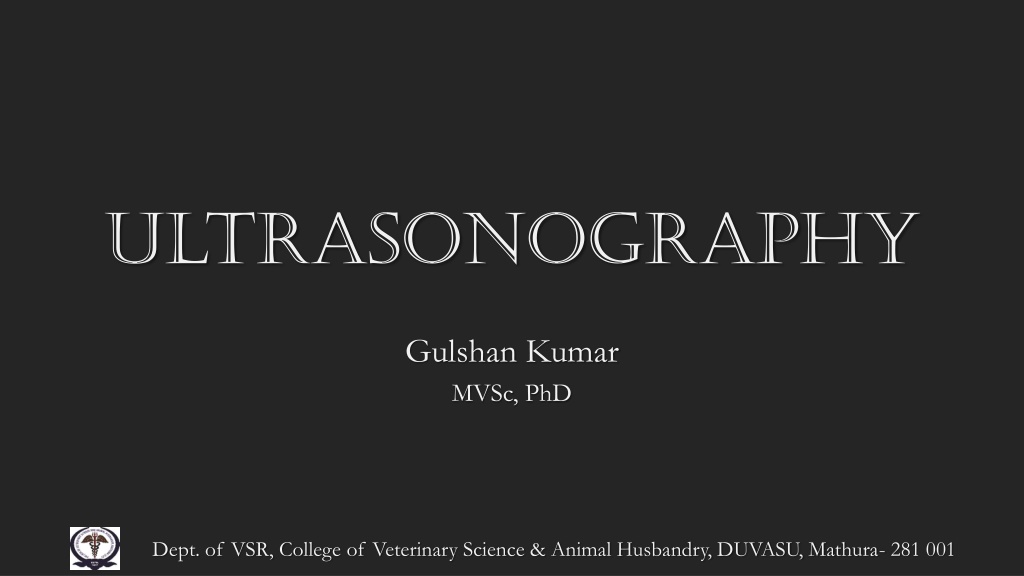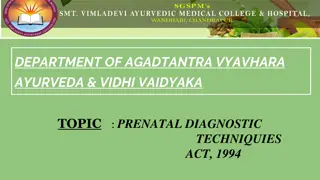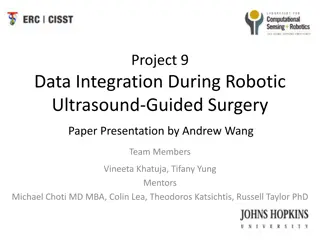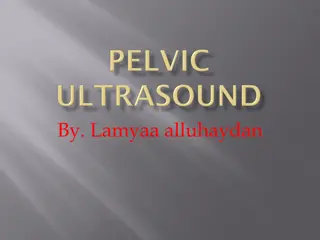Ultrasonography
Ultrasonography in veterinary science is a noninvasive technique providing cross-sectional anatomy of organs by using high-frequency sound waves. It has evolved over the years, from its first use in 1942 for diagnosing brain tumors to modern 3D imaging. Different modes like A, B, and M are utilized, with B-mode being common for diagnosis. The technology relies on the differences in acoustic impedance of tissues to generate images reflecting various degrees of reflection. It has been crucial in diagnosing various conditions in animals, offering valuable insights for veterinary professionals.
Download Presentation

Please find below an Image/Link to download the presentation.
The content on the website is provided AS IS for your information and personal use only. It may not be sold, licensed, or shared on other websites without obtaining consent from the author.If you encounter any issues during the download, it is possible that the publisher has removed the file from their server.
You are allowed to download the files provided on this website for personal or commercial use, subject to the condition that they are used lawfully. All files are the property of their respective owners.
The content on the website is provided AS IS for your information and personal use only. It may not be sold, licensed, or shared on other websites without obtaining consent from the author.
E N D
Presentation Transcript
Ultrasonography Gulshan Kumar MVSc, PhD Dept. of VSR, College of Veterinary Science & Animal Husbandry, DUVASU, Mathura- 281 001
Noninvasive technique Provides cross sectional anatomy of the organs Based on differences in acoustic impedance of the tissue. Image formed by directing high frequency sound waves into the body. Sound waves either travel through the tissues or reflected back to the transducer. Reflected sound waves (echoes) are analyzed by a computer and displayed on a monitor. Dept. of VSR, College of Veterinary Science & Animal Husbandry, DUVASU, Mathura- 281 001
The human ear can process and perceive sound with frequencies ranging from 20 to 20000 Hertz (Hz). Ultrasound- Sound with frequencies higher than 20 kHz Bats use sound waves for navigation and hunting down their prey. The first use of high frequency sound waves is reported to be a futile search of the Titanic in 1912. A similar technique known as sound navigation and ranging (SONAR)- researched massively and usd during the Second World War to detect the presence of underwater enemy vessels (Submarines). Dept. of VSR, College of Veterinary Science & Animal Husbandry, DUVASU, Mathura- 281 001
First used for diagnosis in 1942 for localizing brain tumours. In the 1950 s 2D gray scale still images could be generated whereas real time imaging became possible around 1965. The medical ultrasound uses ultrasound frequencies ranging from 2-10 mHz, more recently 1-13 mHz. Dept. of VSR, College of Veterinary Science & Animal Husbandry, DUVASU, Mathura- 281 001
Ultrasound examination is a search. Examination should provide 3D information about the area under investigation and all the neighbouring organs. Hence requires multiple scans in different projections. Rarely a single scan in one plane provides enough information to allow the correct diagnosis to be made Dept. of VSR, College of Veterinary Science & Animal Husbandry, DUVASU, Mathura- 281 001
Modalities of ultrasound Modes- A, B, M. B-mode is commonly used for diagnosis (brightness mode). Dept. of VSR, College of Veterinary Science & Animal Husbandry, DUVASU, Mathura- 281 001
Greater degree of reflection (stronger echoes), represented on the monitor as an area of white or light gray. Lesser degree of reflection (weaker echoes) allows the more sound wave to pass through unimpeded, represented on the monitor as an area of black or dark gray. Fluids, such as blood, water or urine, transmit sound waves readily. No echoes hence blackness. Dept. of VSR, College of Veterinary Science & Animal Husbandry, DUVASU, Mathura- 281 001
Echoes very strong-complete, Varying degrees of strength but not complete i.e. allows some degree to pass through, No return of echoes i.e. complete transmission Hyper, iso, hypo, an- Dept. of VSR, College of Veterinary Science & Animal Husbandry, DUVASU, Mathura- 281 001
The image presented on the monitor is a distribution of black, grey and white dots, each of which represents return or non return of an echo from tissue interfaces.
Different echogenicities (shades of grey): from hyper echoic to an echoic Dept. of VSR, College of Veterinary Science & Animal Husbandry, DUVASU, Mathura- 281 001
An ultrasonogram thus is essentially an ensemble of several dots varying from white, various shades of grey and black. Experienced sonologists, therefore say, every dot says something. Dept. of VSR, College of Veterinary Science & Animal Husbandry, DUVASU, Mathura- 281 001
Dept. of VSR, College of Veterinary Science & Animal Husbandry, DUVASU, Mathura- 281 001
UB BW Dept. of VSR, College of Veterinary Science & Animal Husbandry, DUVASU, Mathura- 281 001
Contact??? The transducer needs to be in full contact with the skin or mucosa to obtain an informative image. Hair? Surface does not contact the skin adequately, a dark band originating at the near field surface between the skin and probe results Dept. of VSR, College of Veterinary Science & Animal Husbandry, DUVASU, Mathura- 281 001
Dept. of VSR, College of Veterinary Science & Animal Husbandry, DUVASU, Mathura- 281 001
Move the transducer, or apply more gel for better contact between the surface of the skin and transducer, absorption take place. Mineral oil or vegetable oil also provides good contact, but they tend to weaken the rubber coating over the transducer. Dept. of VSR, College of Veterinary Science & Animal Husbandry, DUVASU, Mathura- 281 001
Beam of ultrasound approximately 01 mm thick Traverses through a very thin slice of the tissue/organ. Image obtained is two dimensional- a section (cross/ longitudinal). Orientation Knob /ridge (marker)on the side of the transducer assists in orientation of the image appearing on the monitor. Usually, the knob/ridge side of the transducer appears on the left side of the monitor. General convention -knob/ridge should point in cranial direction(LS), to the right while scanning the midline (TS)and toward dorsal direction when scanning the lateral aspect of the animal (TS). Dept. of VSR, College of Veterinary Science & Animal Husbandry, DUVASU, Mathura- 281 001
What to look for?? Abnormalities in the described size, shape, contours/margins, location/position, number and echotexture (regular or irregular, mottled, multifocal, heteroechoic etc.). Sound knowledge of the anatomy of the area of the proposed site of examination. Dept. of VSR, College of Veterinary Science & Animal Husbandry, DUVASU, Mathura- 281 001
The echogenicity of different organs varies. Necessary to memorise the order of echogenicity of different organs. The echogenicity of some important organs progressively increases in this order: fluid, medulla (kidney), cortex (kidney), liver, spleen, inflamed peritoneum. Dept. of VSR, College of Veterinary Science & Animal Husbandry, DUVASU, Mathura- 281 001
Through tissue layers, the signal becomes attenuated (loses acoustic energy, resulting in a decreased number of ultrasound waves) as the depth of penetration increases. Higher frequencies- lower penetration- higher resolution. Lower frequencies- greater penetration- poor resolution. Dept. of VSR, College of Veterinary Science & Animal Husbandry, DUVASU, Mathura- 281 001
Dept. of VSR, College of Veterinary Science & Animal Husbandry, DUVASU, Mathura- 281 001
Dept. of VSR, College of Veterinary Science & Animal Husbandry, DUVASU, Mathura- 281 001
Fat in the tissue hyperechoic - outlines of the kidney and the sinus brighter. The vessels in the liver appear quite unique. Portal veins have an outer hyperechoic wall due to the fibro- fatty connective tissue surrounding the wall and within the wall itself The hepatic veins can be seen as hypoechoic, do not have hyperechoic walls Dept. of VSR, College of Veterinary Science & Animal Husbandry, DUVASU, Mathura- 281 001
As discussed, the organs/cavities filled with fluid appear anechoic along with an increased echogenicity of the far margins of the cavity and is known as acoustic enhancement Dept. of VSR, College of Veterinary Science & Animal Husbandry, DUVASU, Mathura- 281 001
Another helpful artifact -total reflection of sound waves as seen in calculi in kidney, bladder or gall bladder. Acoustic shadowing results when the sound waves are unable to penetrate the calculus interface and hence no image beyond the interface is formed. Dept. of VSR, College of Veterinary Science & Animal Husbandry, DUVASU, Mathura- 281 001
Another helpful artifact -Reverberation Dept. of VSR, College of Veterinary Science & Animal Husbandry, DUVASU, Mathura- 281 001
In a nutshell Normal anatomy, Observation of deviations from normal appearance in terms of size, shape, echogenicity, etc. Sufficient knowledge of artifacts and the reasons for their appearance. Artifacts occur in all ultrasound images. Also -be systematic about the examinations. Remember, we are imaging differences in acoustic impedance, not anatomy, histology, or even pathology. It so happens that most pathologic conditions in the abdomen correspond with differences in acoustic impedance, but there will be ultrasound misses. Therefore, a negative scan does not always rule out disease. Dept. of VSR, College of Veterinary Science & Animal Husbandry, DUVASU, Mathura- 281 001









